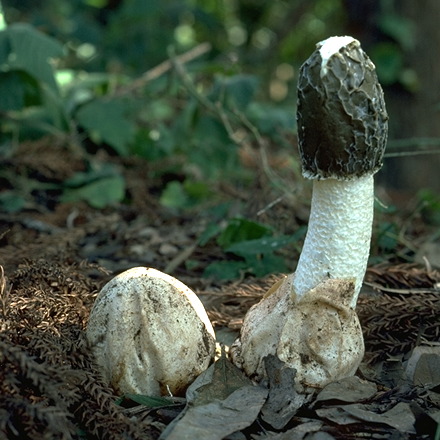Elite life

Mushrooms
Phallus
║ Mushrooms ║
Common Stinkhorn, Gemeine Stink Morchel (Phallus impudicus)

Immature Fruiting Body: Like a whitish to yellowish "egg" up to 6 cm across; usually at least partly submerged in the ground; when sliced revealing the stinkhorn-to-be encased in a gelatinous substance.
Mature Fruiting Body: Spike-like, to 25 cm high; with a cap 1.5-4 cm wide, which is covered with olive brown to dark brown slime; often developing a perforation at the tip; the cap surface pitted and ridged beneath the slime; with a whitish, hollow stem, 1.5-3 cm thick; the base enclosed in a white (Phallus impudicus), sacklike volva, which is often at least partly submerged underground.
Microscopic Features: Spores 3.5 x 1.5-2.5 μm elliptical or oblong; smooth.
Stinkhorn (Phallus hadriani)

Pileus: Fruiting body arising from a buried, egg-like structure, up to 5.0 cm long and 4.0 cm broad, sheathed by a thin, white, soon lilac to pinkish-colored membrane, attached to the substrate via a basal mycelial cord; fruiting body elongating rapidly (within hours) to form a characteristic phallus shape, cap up to 4.0 cm tall, 3.0 cm broad, attached only at the apex, elsewhere appressed to the stipe, the margin sometimes slightly recurved; at maturity, the stipe apex developing an elongated pore, up to 3 cm long and 1.0 cm broad; cap surface coarsely reticulate, the reticulations slightly raised, whitish, coated with olive-grey slime; odor strong, penetrating, disagreeable.
Stipe up to 15 cm long and 3.0 cm thick, equal, hollow, round; surface whitish, becoming cream-colored, spongy in appearance, firm, eventually collapsing in age; a thin, membranous, saccate type volva at the base, pinkish in color, lilac when fresh, lined with gel giving a somewhat swollen appearance; taste mild.
Spores: Spores 3.0-4.5 x 1.5-2 μm, ellipsoid-oblong, smooth; olive-grey in mass. Edible in the egg stage; untried locally.
Ravenel's Stinkhorn (Phallus ravenelii)
Immature Fruiting Body: Like a whitish to pinkish "egg"; when sliced revealing the stinkhorn-to-be encased in a gelatinous substance.
Mature Fruiting Body: Spike-like, to 20 cm; with a 3 to 4.5 cm cap which is smooth (or slightly roughened, but not pitted and ridged) and covered with olive brown to dark brown slime; developing a small hole with a white rim at the tip of the cap; with a whitish to yellowish or pinkish hollow stem, 1.5-3 cm thick; usually with a white or pink volva clinging to the stem and around the base; the base attached to whitish rhizomorphs.
║ Mushrooms ║